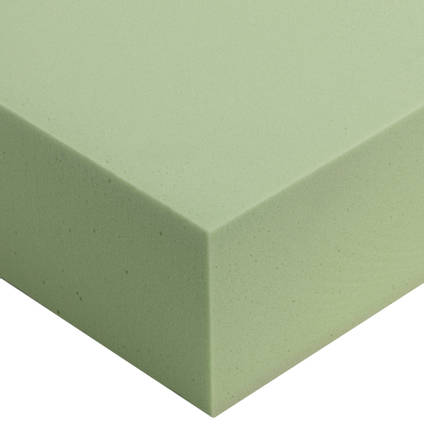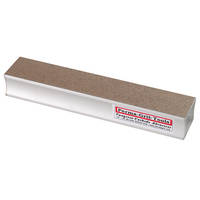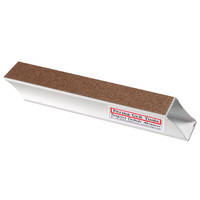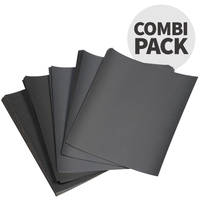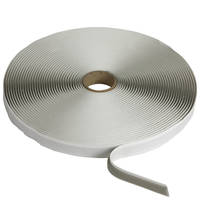Need any help or advice?+44 (0)1782 454499
Specification
Weight and Dimensions
| Length | 300 | mm |
|---|---|---|
| Thickness | 100 | mm |
| Width | 300 | mm |
Product Data
| Colour | Green | |
|---|---|---|
| Chemistry / Material | Polyurethane | |
| Density | 96 | kg/m³ |
| Compressive Strength | 1.05 | MPa |
Mechanical Properties
| Max Service Temp | 100 | °C |
|---|---|---|
| Tensile Strength | 1.06 | MPa |
Compatible With
| Compatible With | Epoxy | Yes |
|---|---|---|
| Compatible With | Polyurethane | Yes |
| Compatible With | Polyester | Yes |
| Compatible With | Vinylester | Yes |
| Compatible With | RTV Silicone | Yes |
General Properties
| Gross Weight | 0.864 | kg |
|---|
Shipping Information
Restrictions
This product is not classed as dangerous goods for transport and can be shipped to all destinations without restriction.
Shipping to EU countries is now done through our European subsidiary based in the Netherlands. All EU customers should use www.easycomposites.eu.
Package Size
There are no package size restrictions or surcharges for this product.
Delivery Cost
To find the delivery cost of this item to your address, add it to your basket and then use the instant shipping calculator on the basket page.
PF90 High Density Polyurethane Foam
- PUF90-03-03
- No reviews
90kg/m³ polyurethane (PU) foam block ideal for composite pattern making. This high density foam can be used to produce sturdier, more detailed patterns. It can still be cut and shaped by hand but is also well suited to CNC machining. Also suitable for use as a buoyancy foam or structural core material in larger applications.
The foam is 100mm thick and available to buy online in a range of block sizes from 300 x 300mm to 1220 x 1220mm.
PRODUCT VERSIONS
Sheet Size
AVAILABILITY:9 in stock available for immediate shipping
We won’t be beaten on price!
If you believe you’re buying an equivalent product cheaper elsewhere, contact us to discuss your requirements.
High density PU foam block ideal for making sturdy patterns with precise surface detail and a high quality surface finish.
Our 100mm thick High Density Polyurethane Foam Block has a nominal density of 96kg/m³. Also available is our Low Density Polyurethane Foam Block with a nominal density of just 48kg/m³.
Advantages
Perfect for large patterns and fast hand working:
- Can be cut and shaped by hand or machined.
- High density results in sturdy, durable patterns (which can be walked on).
- Dimensionally stable (will not expand or contract).
- Compatible with epoxy, polyester and vinylester resin systems.
- Can be finished to a high standard with a range of surface coats.
How to Use
Our High Density Polyurethane Foam Block is available in 100mm thick block sizes of: 600x600mm, 600x1200mm and 1200x1200mm. Please choose the block size you require from the drop-down list.
Multiple blocks of foam can easily be bonded together to create very large patterns (full vehicle bodies, for example).
Further Information
Marine Use / Core Material Use
As well as use as a pattern making foam block this High Density Polyurethane Foam Block is also intended for use (and approved for use) as a structural core material. Core materials can be used in GRP structures to increase stiffness for load bearing purposes, reducing weight, cost and laminating time.
Our High Density Polyurethane Foam Block carries Lloyds approval as a rigid core material for marine use making it also ideally suited for use as a composites core material in applications like boat decks and bulkheads where lightness, low resin uptake and cost are important factors.
Lloyds Registry of Shipping Approved Certificate of Acceptance No. YSL/SA/019 (for yachts up to 45' in length).
High density PU foam block ideal for making sturdy patterns with precise surface detail and a high quality surface finish.
Our 100mm thick High Density Polyurethane Foam Block has a nominal density of 96kg/m³. Also available is our Low Density Polyurethane Foam Block with a nominal density of just 48kg/m³.
Advantages
Perfect for large patterns and fast hand working:
- Can be cut and shaped by hand or machined.
- High density results in sturdy, durable patterns (which can be walked on).
- Dimensionally stable (will not expand or contract).
- Compatible with epoxy, polyester and vinylester resin systems.
- Can be finished to a high standard with a range of surface coats.
How to Use
Our High Density Polyurethane Foam Block is available in 100mm thick block sizes of: 600x600mm, 600x1200mm and 1200x1200mm. Please choose the block size you require from the drop-down list.
Multiple blocks of foam can easily be bonded together to create very large patterns (full vehicle bodies, for example).
Further Information
Marine Use / Core Material Use
As well as use as a pattern making foam block this High Density Polyurethane Foam Block is also intended for use (and approved for use) as a structural core material. Core materials can be used in GRP structures to increase stiffness for load bearing purposes, reducing weight, cost and laminating time.
Our High Density Polyurethane Foam Block carries Lloyds approval as a rigid core material for marine use making it also ideally suited for use as a composites core material in applications like boat decks and bulkheads where lightness, low resin uptake and cost are important factors.
Lloyds Registry of Shipping Approved Certificate of Acceptance No. YSL/SA/019 (for yachts up to 45' in length).
Specification
Weight and Dimensions
| Length | 300 | mm |
|---|---|---|
| Thickness | 100 | mm |
| Width | 300 | mm |
Product Data
| Colour | Green | |
|---|---|---|
| Chemistry / Material | Polyurethane | |
| Density | 96 | kg/m³ |
| Compressive Strength | 1.05 | MPa |
Mechanical Properties
| Max Service Temp | 100 | °C |
|---|---|---|
| Tensile Strength | 1.06 | MPa |
Compatible With
| Compatible With | Epoxy | Yes |
|---|---|---|
| Compatible With | Polyurethane | Yes |
| Compatible With | Polyester | Yes |
| Compatible With | Vinylester | Yes |
| Compatible With | RTV Silicone | Yes |
General Properties
| Gross Weight | 0.864 | kg |
|---|
Polyurethane is a highly chemically inert material meaning that the vast majority of solvents and household chemicals will not dissolve the PU foam at all.
We are not aware of any easily available solvents or relatively safe to use chemicals that will dissolve the PU foam. If you did need a foam that is more readily dissolved then expanded polystyrene (EPS) such as Styrofoam might make a better choice.
Although perfectly possible to cut the Low Density Foam by water jet, it is more common to use other more simple manual methods. But for more precise applications, the foam works well with all CNC cutting and routing operations where the foam can be easily machined to a shape or pattern
No, it's expanded polystyrene foam (like styrofoam/blue foam) that you can cut with a hot-wire cutter. To cut PU foam you will need a blade of some description.
It's completely rigid. If it is 'hit' it will dent and stay dented. The way to think of this type of foam that helps people the most is that it's similar to (albeit higher density and therefore stronger) Oasis - the type of foam used for dried flower arranging. Therefore, although it would absorb impact from a shock, it would deform and stay deformed.
Our Pattern Coat Primer product is excellent for sealing foam and lower density modelboards. On lower density foams you might also choose to use a scrim of glass cloth to add some more strength to your pattern first. When using the Pattern Coat Primer, a typical thickness would be around 0.5mm.
Yes, our High Density Polyurethane Foam Block is suitable (and approved) for use as a structural core material.
Our High Density Polyurethane Foam Block carries Lloyds approval as a rigid core material for marine use making it also ideally suited for use as a composites core material where lightness, low resin uptake and cost are important factors.
Another product worth consideration for the same application would be our EasyCell75 Closed Cell PVC Foam. The EasyCell is a bit more practical for thinner boards as it is available in a number of thicknesses ranging from 3mm to 25mm and thus would need less machining and have less waste. It also has a slightly finer cell structure which means less resin uptake at the bond-line.
Yes, PU foams and model boards can be cut by laser cutters.
PF90 can be bonded by most adhesives but we tend to recommend foaming PU adhesives as they tend to result in a join with similar density and similar sanding and machining properties as the original foam. This means you are less likely to get a hardline between joined blocks. A common and easy to find brand is the original Gorilla glue.
No, this foam is not rated for fire protection.
This PU foam is a 'closed cell' foam and so if the foam was exposed there would not really be any water uptake in the short to medium term. For example, if you submerged a block of this foam in water for a number of hours and then removed it, there would be almost no measureable water uptake. If the damage was left unrepaired in the very long-term then water ingress into the damaged laminate along with pooled water in the damaged area would eventually start to deteriorate the foam and surrounding laminate so it is certainly advisable to repair any such damage correctly within a reasonable timeframe.
The PU90 has a heat distortion temperature of 75C which would make it unsuitable for many vacuum forming processes due to heat. Also in its natural state, it has a matt finish, which we have found in testing, is very difficult get a good release from meaning that the part may well stick to the mould or damage the mould during the release.
A better product would be our Vac Cast Epoxy Casting Resin which is an aluminium filled and stabilised epoxy based casting resin ideal for vacuum forming tools.
Although it is technically possible to make a surf board from this foam, we would not recommend it.
This foam is primarily designed for pattern making applications meaning it is more rigid than a typical surfboard so would not provide the same kind of flex. It would also be more vulnerable to fracture and hence not as durable in a practical sense
ASK YOUR OWN QUESTION
Customer Product Reviews for PF90 High Density Polyurethane Foam
SUBMIT YOUR OWN PRODUCT REVIEW
We publish all reviews for verified purchases. Submit your own review and help other customers with their choices.SUBMIT YOUR OWN PRODUCT REVIEW
We publish all reviews for verified purchases. Submit your own review and help other customers with their choices.Shipping Information
Restrictions
This product is not classed as dangerous goods for transport and can be shipped to all destinations without restriction.
Shipping to EU countries is now done through our European subsidiary based in the Netherlands. All EU customers should use www.easycomposites.eu.
Package Size
There are no package size restrictions or surcharges for this product.
Delivery Cost
To find the delivery cost of this item to your address, add it to your basket and then use the instant shipping calculator on the basket page.
RELATED PRODUCTS
CUSTOMERS ALSO PURCHASED
RELATED PRODUCTS
CUSTOMERS ALSO PURCHASED
100% SECURE
PAYMENT METHODS


Easy Composites Ltd, registered in England 7486797. All content copyright (C) Easy Composites Ltd, 2025. All rights reserved.
